
Summer 2022
they must feed frequently. Or, better yet consume large meals with minimal energy expanded.
Now for the bass it would be wonderful if stocked trout and fingerling Kokanee swam the shorelines for the taking. But, that’s just not the case. Those species search for cold water and roam in expanses making them a difficult meal for the bass to target, during the summer months. Shad and crawdads are always on the menu, but sometimes can be more effort than it’s worth. Heck, this is why they eat their own offspring in the latter months of spring. So, what’s left on the chopping block? You guessed it bluegill and any other small varieties of sunfish.
Why is it that these bluegills become such a sought- after source of forage?
It’s really quite simple.
These smaller fish move into the skinniest warmest water to spawn just weeks after the bass. But, that’s only one part to the equation. The other reason the bass eat them is they are the enemy. Bluegill will pillage a bass nest, and devour clusters of bass fry. Making themselves a target in multiple ways for post spawn bass. And, these little sunfish have one of the most
®
unfortunate markings to help bass identify them. That is a bright chartreuse tail, that is undeniably once spotted. That is the target of the enemy.
So now that we’ve determined what the bass while eat/kill, let’s discuss a versatile bait selection that will allow us to target various depths and structure types. Then we will discuss where to fish them.
The simplest presentation to replicate a bluegill would be a soft plastic. There is an endless number of possibilities, so I will keep it simple. The main focus when making a selection is, size, color and profile. Obviously,
we want these three to somewhat reassemble a bluegill.
Then there are rigging methods as well. Think like a
fish. A shakey head looks like an egg-eater, a dropshot
has a suspended fish quality, and a Texas-rig can be put
into heavy cover to trigger a reaction strike. However,
the most important detail to the entire equation……is
the target.
That’s right, a bright chartreuse tail will allow the
bass to correctly identify the species. At this point the
bass will bite it to eradicate it or to fill their bellies. Or
both?
Next there is a plethora of reaction style
(subsurface) baits to use. And, these I would select
based upon their fishability. Access the cover
present and determine the appropriate selection.
page
47